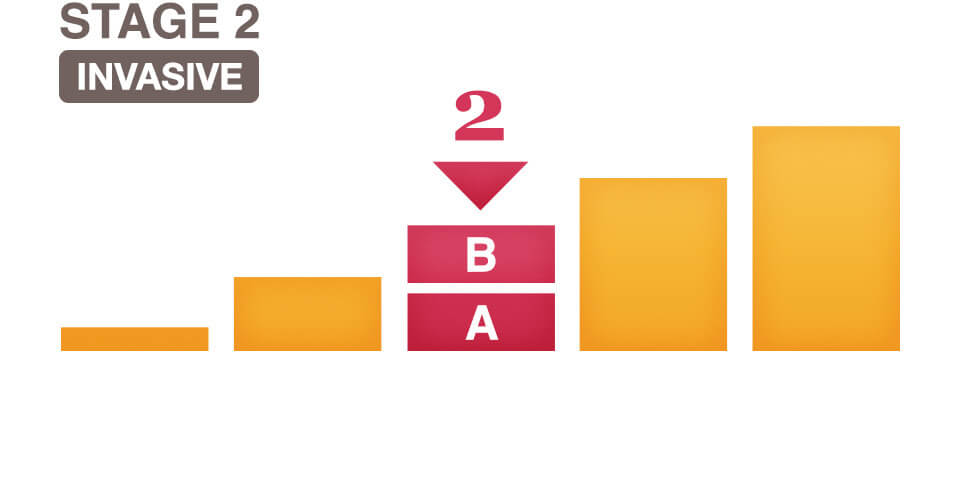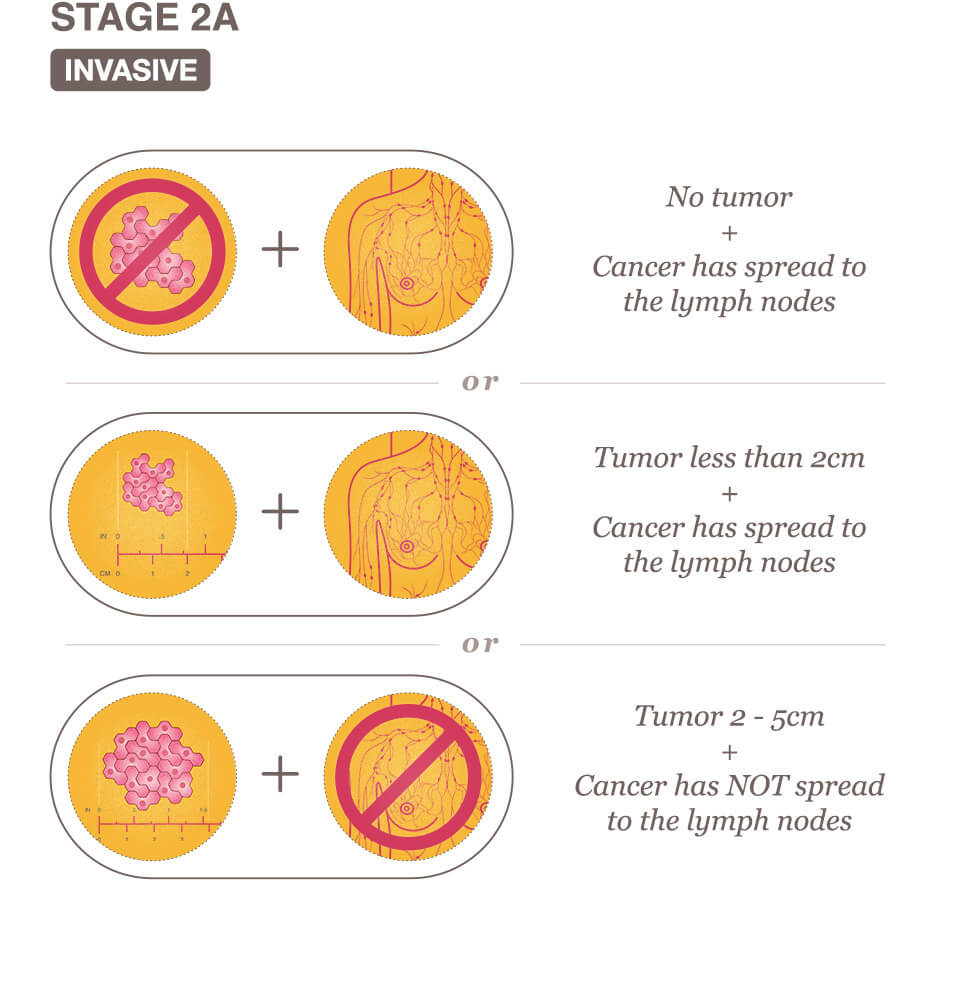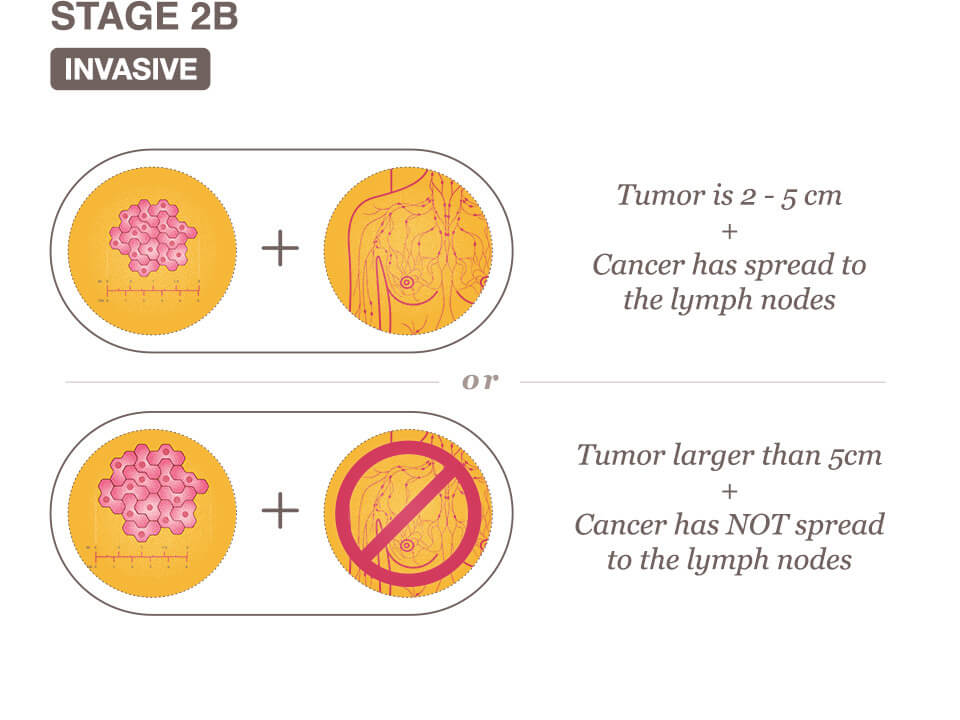Stage 2 Breast Cancer Overview
What does it mean to have Stage 2 breast cancer?
Stage 2 breast cancer is classified as being relatively early stage, invasive breast cancer. In Stage 2, the breast cancer has grown, but it is still contained in the breast tissue or growth has only extended to axillary lymph nodes (the lymph nodes nearest the breast).

Stage 2 breast cancer is divided into two substages, or groups: Stage 2A and Stage 2B. The type of substage is determined by the size of the tumor and whether the breast cancer has spread to nearby lymph nodes, usually those located in the underarm.
Stage 2A breast cancer
Stage 2A breast cancer is a type of invasive breast cancer that is contained in the breast tissue or has spread only to nearby lymph nodes.
Stage 2A breast cancer means one of the following descriptions applies:

There are cancerous cells in the breast tissue and less than four axillary lymph nodes contain cancer cells.
OR
The tumor is less than 2 centimeters, and less than four axillary lymph nodes contain cancer cells.
OR
The tumor is between 2 and 5 centimeters and has not yet spread to the lymph nodes.
Stage 2B breast cancer
Stage 2B breast cancer means that the tumor is larger or cancer cells have spread further into the lymph nodes than in Stage 2A.
Stage 2B breast cancer means one of the following descriptions applies:
The tumor is between 2 and 5 centimeters and has spread to less than four axillary lymph nodes.
OR
The tumor is larger than 5 centimeters but has not spread to any axillary lymph nodes.

Stage 2 breast cancer symptoms
Stage 2 breast may typically be discovered during a routine mammogram and may not cause any signs and symptoms. If Stage 2 breast cancer symptoms are present, they may include:
- A new lump or thickening in or near the breast or in the underarm area
- Any unexplained change in the size or shape of the breast, including swelling or shrinkage (especially if on one side only)
- Dimpling anywhere on the breast
- Puckering in the skin of the breast
- A nipple turned inward (inverted) into the breast
- Discharge (fluid) from the nipple (particularly clear or bloody discharge)
- A change in the skin texture, discoloration, swelling, or an enlargement of pores in the skin of the breast (some describe this as similar to an orange peel’s texture)
- Scaly, red, or swollen skin on the breast, nipple, or areola
- Recent asymmetry (unequal or lack of sameness) of the breasts
If you notice any of these signs or symptoms, talk to your doctor immediately.
Stage 2 breast cancer treatment
When you are diagnosed with Stage 2 breast cancer, you will meet with your oncologist and breast cancer care team to determine the best course of treatment for your specific cancer.
The types of therapies you receive, and when you receive them, will depend on several factors, including the type of breast cancer you have, prognostic tumor test results (including ER, PR, HER2, grade, and Ki67), and your age and menopausal status. Your general health and other medical conditions may also be factored into the treatment planning process. Based on all these factors, your breast cancer care team will help you determine which treatments are best suited to your situation
Stage 2 breast cancer is often treated with both systemic therapies (drugs that travel throughout the entire body) and local therapies (treatments that are applied to a specific area of the body, such as the breast and underarm lymph nodes.
Common treatments for Stage 2 breast cancer include:
- Chemotherapy: Chemotherapy is a systemic treatment in which cancer-fighting drugs travel throughout the entire body through the bloodstream. Chemotherapy can be given before or after surgery and is often used in conjunction with other systemic treatments, including targeted therapy and hormonal therapy. Chemotherapy drugs, given intravenously (IV) or orally (a pill), work by destroying cancer cells or limiting their growth.
- Targeted therapy: Targeted therapy, often given in conjunction with chemotherapy and hormone therapy, is a systemic treatment for breast cancer. Targeted therapy, given in either pill or IV form, works by blocking the growth of breast cancer cells.
- Hormonal therapy: Hormonal therapy is a systemic treatment for breast cancer that is hormone receptor-positive (ER+, PR+, or both ER/PR+). Hormonal therapy works by starving estrogen-positive (ER+) and progesterone-positive (PR+) breast cancer cells by cutting off their supply of hormones. Hormonal therapy is often used in conjunction with chemotherapy. It is not considered an effective treatment for triple negative breast cancer.
- Surgery: Surgery, including mastectomy or lumpectomy, is often used to treat Stage 2 breast cancer. The nearby axillary lymph nodes will also be checked for cancerous cells, either with a sentinel lymph node biopsy or an axillary lymph node dissection. Breast cancer surgery is often followed by radiation in the treatment of Stage 2 breast cancer.
- Radiation therapy: Radiation therapy uses high-energy rays to kill cancer cells. It affects only the cells in the part of the body that is being radiated. Radiation is often used after breast cancer surgery to destroy any remaining cancerous or mutated cells that remain in the breast or armpit area.
Each type of treatment for Stage 2 breast cancer comes with different side effects. Read more about breast cancer treatment side effects and how to manage them.
Stage 2 breast cancer treatment timeline
The time required to treat Stage 2 breast cancer varies by the types of treatment that are undertaken, how long those treatments need to be administered, and if they can be administered at the same time. A Stage 2 breast cancer patient can expect to be in active treatment for breast cancer for 3-18 months or longer, depending on the course of treatments required.
In addition to active treatment for breast cancer, many Stage 2 breast cancer patients whose cancer is estrogen receptor-positive (ER+) can expect to be on some form of hormonal treatment for 5-10 years after their diagnosis. For tumor cells that are HER2+, biologic targeted therapies may be given for a total of one year.
Stage 2 breast cancer survival rate
The survival rate for breast cancer is determined using the relative survival rate. The relative survival rate compares women with the same type and stage of breast cancer to women in the overall population. The American Cancer Society uses a 5-year relative survival rate, which calculates survival rates for the 5-year period after a breast cancer diagnosis.
The survival rate for Stage 2 breast cancer depends upon whether or not the cancer has spread to the lymph nodes:
- If cancer has not spread to the lymph nodes, as in Stage 2A, the cancer is considered localized, meaning there is no sign that cancer has spread outside of the breast. The 5-year relative survival rate for localized breast cancer is 99%.
- If cancer has spread to the lymph nodes, as in some Stage 2A and 2B breast cancers, the cancer is considered regionally advanced, meaning the cancer has spread outside the breast into nearby structures or lymph nodes. The 5-year relative survival rate for regionally advanced breast cancer is 87%.
Breast cancer survival rates by SEER* stage
| SEER stage | 5-year relative survival rate |
| Localized: There is no sign that cancer has spread outside of the breast. Includes only invasive breast cancers, not DCIS. | 99% |
| Regional: The cancer has spread outside of the breast into nearby structures or lymph nodes. | 87% |
| Distant: The cancer has spread to distant parts of the body, such as the bones, lungs, liver, or brain. | 32% |
| All SEER stages combined | 91% |
**Table information provided by the American Cancer Society
Prognostic factors of Stage 2 breast cancer, such as ER, PR, and HER2 status, also play a key role in survival rates. Speak with your doctor to determine your prognostic factors and how they may impact your specific survival rate.
Stage 2 breast cancer prognosis
The overall prognosis for Stage 2 breast cancer is generally good. However, certain types of Stage 2 breast cancer may have a better prognosis than others. This is because some breast cancers, like those that are hormone receptor-positive (HR+) and HER2-negative, tend to be more responsive to hormonal therapy than other types of breast cancer. Likewise, HER2-positive breast cancer may be more receptive to certain types of targeted therapies. Other types of Stage 2 breast cancer, such as triple negative breast cancer, have fewer treatment options, as well as a higher rate of breast cancer recurrence.
Stage 2 breast cancer recurrence rates vary greatly from person to person depending on the characteristics of the original breast cancer. These characteristics include the biological makeup of the tumor (hormone receptor and HER2 status), whether or not the cancer had spread outside of the breast (Stage 2A or Stage 2B), and treatments undertaken to treat the original cancer.
After treatment for Stage 2 breast cancer, survivors can expect to have a relatively normal and high quality of life. However, it is important that breast cancer survivors attend all follow-up medical appointments and report any new or worsening signs or symptoms of breast cancer to their doctor immediately.
Other ways to reduce your risk of breast cancer recurrence is to adopt a healthy lifestyle through increased physical activity, eating healthily, reducing alcohol intake, and not smoking, among others. Read more about breast cancer risk factors.
Know the Breast Cancer Risk Factors
Download the free Healthy Living & Personal Risk Guide to learn more about the risk factors for breast cancer and how you can lower your risk.
Healthy Living & Personal Risk GuideStage 2 breast cancer FAQs
Is Stage 2 breast cancer curable?
Very few doctors and healthcare professionals use the term “curable” to describe breast cancer today. Instead, they may the term “cancer free.” Stage 2 breast cancer has a generally good prognosis, with many Stage 2 breast cancer patients being termed “cancer free” at the end of their treatment.
Do you need chemo for Stage 2 breast cancer?
Chemotherapy is one of the most common forms of treatment for Stage 2 breast cancer. Chemotherapy for Stage 2 breast cancer can be administered before breast cancer surgery, called neoadjuvant chemotherapy, or may be administered after surgery. It is sometimes administered both before and after surgery.
How quickly does breast cancer go from Stage 1 to Stage 2?
While there is no hard and fast statistic for how quickly Stage 1 breast cancer advances, we do know that the tumor grade assigned to breast cancer cells impacts the speed of cancerous growth; typically the higher the grade, the faster the spread. However, the speed of growth may vary from person to person, with some cancerous cells spreading to lymph nodes in as little as 6-8 weeks, while it may take months in other cases. Speak with your doctor to determine the grade of your breast cancer and how it may impact the rate at which it may spread.
To be proactive, patients should focus on getting some form of treatment underway within 6 weeks of the biopsy date confirming they have Stage 2 breast cancer.
Can Stage 2 breast cancer spread to the bones?
Stages 1, 2, and 3 breast cancers all have the ability to spread to other organs in the body, including the bones. If breast cancer spreads to other organs in the body, it is called Stage 4 breast cancer, or metastatic breast cancer, where the breast cancer cells use the blood stream or lymph nodes to spread beyond the breast and lymph nodes under the arm. Metastasizing (spreading) to the bones is the most common area for breast cancer to spread to.
There is a tendency for a breast cancer survivor to assume that any ache or pain, especially bone or muscle pain, is associated with metastatic breast cancer in the bones. Talk with your doctor about what signs and symptoms to watch for, but also try not to get so focused on worrying about the cancer one day spreading that it impacts your quality of life.
Stage 2 breast cancer stories of hope
No matter the stage of breast cancer, NBCF is here to offer help and hope.
Read Stage 2 breast cancer stories of hope on the NBCF blog:
Trisha’s Journey as a Young Mom with Breast Cancer
Breast Cancer at 36: Conquering Fear with Hope and Community



